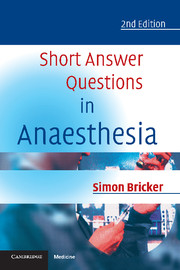Book contents
- Frontmatter
- Contents
- Preface
- Preface to the 1st edition
- Abbreviations
- 1 Advice on answering short answer questions
- 2 General Anaesthesia
- 3 Anaesthesia and Medical Disease
- 4 Medicine and Intensive Care
- 5 Obstetric Anaesthesia and Analgesia
- 6 Paediatric Anaesthesia
- 7 Neuroanaesthesia
- 8 Acute and Chronic Pain
- 9 Trauma and Emergency Anaesthesia
- 10 Anatomy, Applied Anatomy and Regional Anaesthesia
- 11 Pharmacology and Applied Pharmacology
- 12 Clinical Measurement and Equipment
- 13 Cardiac and Thoracic Anaesthesia
- Index
1 - Advice on answering short answer questions
Published online by Cambridge University Press: 05 February 2014
- Frontmatter
- Contents
- Preface
- Preface to the 1st edition
- Abbreviations
- 1 Advice on answering short answer questions
- 2 General Anaesthesia
- 3 Anaesthesia and Medical Disease
- 4 Medicine and Intensive Care
- 5 Obstetric Anaesthesia and Analgesia
- 6 Paediatric Anaesthesia
- 7 Neuroanaesthesia
- 8 Acute and Chronic Pain
- 9 Trauma and Emergency Anaesthesia
- 10 Anatomy, Applied Anatomy and Regional Anaesthesia
- 11 Pharmacology and Applied Pharmacology
- 12 Clinical Measurement and Equipment
- 13 Cardiac and Thoracic Anaesthesia
- Index
Summary
Postgraduate examinations evolve in mysterious ways, and so when puzzled candidates for the Final FRCA query the rationale for a twelve-question short answer paper they may find the answer opaque. The ‘educationalists’, they are told, believe that the paper should contain not just twelve questions, but should have as many as twenty, if not more. It is as if the invocation of this higher educational authority is meant to explain everything about the science of examinations: despairing candidates meanwhile have to count themselves lucky that they only have to answer a mere 12 questions in 3 hours. You may be surprised to know that at least some of the Final examiners share this unease about the current format. There are concerns that the pressure imposed by having to complete an answer in less than 15 minutes militates against the original purpose of this part of the examination, which was ‘to assess the understanding of facts, and judgement, understanding and communication skills.’ Examiners are aware that you face a significant challenge and you may even start this part of the examination with their sympathy.
The composition of the paper
The Final FRCA in its current format dates from November 1996 and the initial information from the College about the short answer section stated that, in this new part of the examination ‘…questions will tend to follow the pattern of including a question which relates to the following areas: paediatric, neurosurgical, obstetric, cardiothoracic, trauma and emergency, acute and chronic pain, medicine and surgery, clinical measurement, regional and local anaesthesia, dental and maxillo-facial anaesthesia, ENT and ophthalmic anaesthesia, and intensive care medicine.’
- Type
- Chapter
- Information
- Short Answer Questions in Anaesthesia , pp. 1 - 12Publisher: Cambridge University PressPrint publication year: 2002



